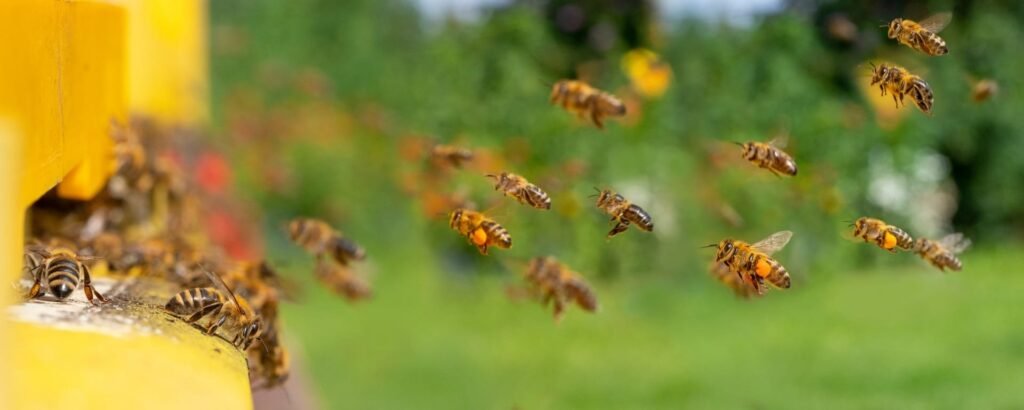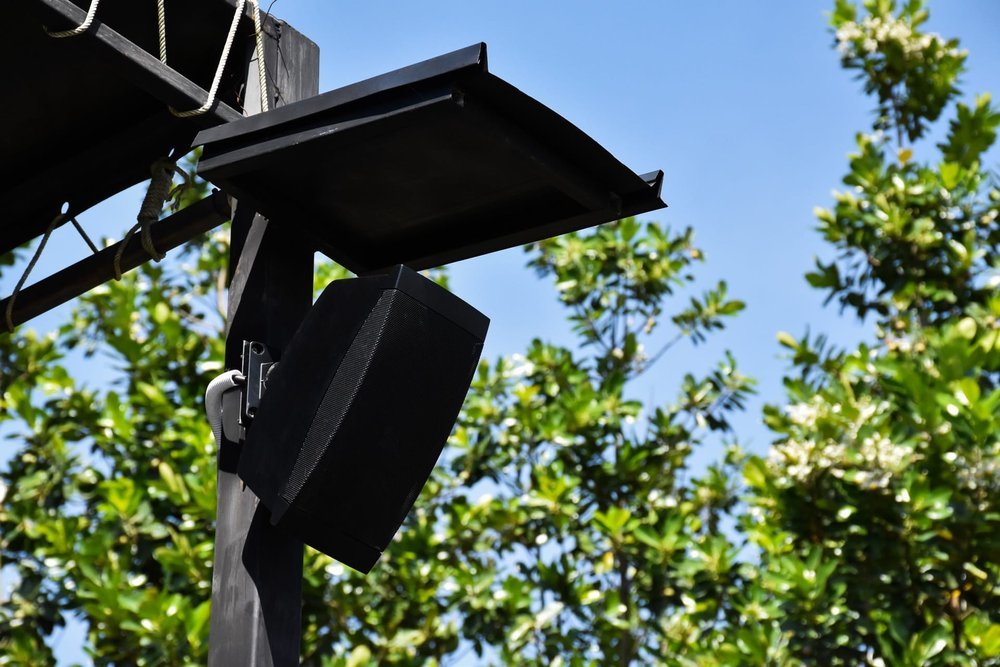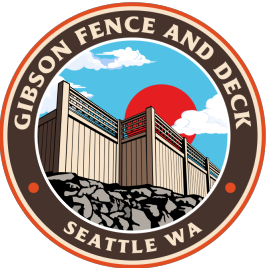Protecting Decks from Carpenter Bees

Wooden decks enhance outdoor living spaces with their beauty and functionality but are susceptible to damage from carpenter bees. These insects bore into wood to create nests, weakening the structure and potentially leading to costly repairs. Managing carpenter bee infestations effectively is crucial for maintaining the structural integrity and appearance of your deck. Effective strategies are available to protect your deck from these destructive insects, ensuring its longevity and aesthetic appeal. Insects are one of the primary factors impacting the lifespan of a wood deck, so proactivity is the name of the game. The full cost of a new wood deck is a serious investment, don’t let carpenter bees burn up your dollars right beneath your nose.

How To Address an Active Carpenter Bee Infestation
Effective management of carpenter bee infestations involves spraying residual insecticide, using dust in nests, and plugging up existing holes to preserve wooden decks.

Spray a Residual Insecticide: Areas visibly affected by carpenter bees benefit from treatments with long-lasting insecticides like Cyzmic CS or Demon WP. These insecticides create a protective barrier that not only kills existing bees but also prevents new ones from establishing nests. It is crucial to apply the insecticide directly into the tunnels and on wood surfaces where activity is noted.
Use Dust in Carpenter Bee Nests: Insecticidal dust, such as Tempo Dust, should be applied directly into the nest holes following the spray treatment. This dust is particularly effective because it adheres to the bodies of the bees as they move through the treated areas, reaching deep into parts of the nest that sprays cannot penetrate. This method is vital for targeting bee larvae and the female carpenter bees that maintain the nests.
Plug Up Existing Carpenter Bee Holes: After ensuring that the bees have been eradicated from the nests, sealing the entry points is essential. Filling the holes with wood putty prevents carpenter bees from reusing them and helps maintain the structural integrity and appearance of the deck. For larger or more damaged holes, a stronger filler may be necessary, or professional advice may be sought for structural repairs.
Identifying Carpenter Bees, Carpenter Bee Holes, and Their Damage

Carpenter Bees vs. Other Bees
Carpenter bees can be confused with other bees like honey bees and bumble bees, but they have distinctive physical and behavioral traits:
Appearance: Carpenter bees are large with a black, shiny, and smooth abdomen, contrasting with the hairy, more colorful abdomen of bumble bees. Unlike honey bees, which are social and swarm, female carpenter bees and other carpenter bees are solitary and do not form hives.
Behavior: They are not aggressive unless provoked. Male carpenter bees may hover and dart aggressively but lack stingers, exhibiting shiny abdomens as they attempt to attract female mates. Females can sting but rarely do unless handled or threatened.
Signs of Carpenter Bee Infestation
Early detection of carpenter bees can prevent severe damage to wooden structures. Key indicators include:
Carpenter Bee Holes: Look for perfectly round holes about half an inch in diameter. These are entrance holes to their nests drilled into wood surfaces, a clear sign of carpenter bees on deck.
Sawdust: Small piles of little sawdust beneath the entry holes indicate active boring. This sawdust results from the bees excavating tunnels to lay eggs, often found near wooden areas of the house.
Nest Holes: Besides the initial entrance, there may be larger, less uniform tunnel openings deeper within the wood, often hidden from direct view. These areas might require a carpenter bee trap or bee trap to manage the infestation effectively.
Buzzing Sounds: A faint but persistent buzzing noise may be heard from the activity within the wood, signifying that bees are at work inside. This is often the first sign noticed when attempting to kill carpenter bees or get rid of carpenter bees.

Preventive Measures
To deter carpenter bees from nesting, choosing appropriate building materials and maintaining wood surfaces are crucial. Cement board siding offers a strong alternative to traditional wood, inherently resistant to wood-boring insects. Similarly, metal flashing can be strategically placed to block access to potential nesting sites, adding an extra layer of protection.
Regular maintenance is another vital preventive strategy. Applying a fresh coat of paint, stain, or varnish not only enhances the appearance of wood surfaces but also seals them against carpenter bees. These treatments act as barriers, discouraging bees from drilling into the wood.
In addition to these structural and maintenance strategies, natural deterrents provide a chemical-free option for repelling carpenter bees. Spraying wood surfaces with citrus-based oils can effectively keep these pests at bay due to the strong scent that bees find unattractive. Almond oil, another powerful natural repellent, can be used similarly to create an environment less appealing to carpenter bees.
By integrating these materials, maintenance practices, and natural deterrents into the care of wooden structures, the likelihood of carpenter bee infestations can be greatly reduced, preserving the integrity and beauty of wood-based designs.
Long-Term Solutions and Monitoring

Installing and maintaining carpenter bee traps provides effective control over bee populations by mimicking natural nest openings, attracting and trapping the bees. These traps should be strategically placed around the perimeter of wooden structures, and regular maintenance, including the removal of trapped bees and periodic checks for wear, is essential to their continued effectiveness.

Engaging in proactive maintenance during key seasonal transitions significantly deters carpenter bee activity. In the fall, sealing any cracks or small openings with caulk or wood putty prevents bees from establishing nests. The spring requires a thorough inspection to identify and address any new or potential nesting sites early, helping to control infestations before they cause significant damage.

Conducting routine inspections is critical for spotting early signs of carpenter bee activity, such as new holes or accumulations of sawdust. Addressing these signs promptly by repairing the damage, filling holes, and refinishing the wood not only preserves the structure but also makes it less inviting for future infestations.

Incorporating hardwoods in the construction of exposed wooden elements acts as a natural deterrent to carpenter bees. Hardwoods, being tougher to penetrate, are less attractive to bees for nesting, thereby reducing the risk of damage and ensuring a longer life than that of untreated cedar or other softwoods.

Installing physical barriers such as wire screening over potential nesting sites effectively prevents access by carpenter bees. These barriers are ideally placed in secluded areas like under eaves or along fence lines to block bees from reaching the wood, thus protecting these vulnerable spots.

Using vibrational and auditory deterrents disrupts carpenter bees’ nesting behavior. Options such as playing loud music or employing devices that emit vibrations near infestation zones leverage the bees’ sensitivity to disturbances, making the area less desirable for nesting.

Adjusting landscaping to include flowering plants positioned away from wooden structures redirects carpenter bees to other areas of the yard. This strategic placement not only keeps bees away from important structures but also benefits garden pollination, striking a balance between control and conservation.

Supplemental Measures
Employing diatomaceous earth and insecticidal dust serves as a natural abrasive and control method around potential nesting sites, deterring carpenter bees by damaging their exoskeletons and eliminating larvae and adults residing inside. These substances focus treatment directly at affected areas without widespread chemical use.
Implementing auditory deterrents like playing loud music or employing devices that generate significant noise can be effective in disrupting carpenter bee activity. These methods are particularly useful in regions where bees are a persistent problem, as the consistent auditory stimuli discourage bees from establishing nests.
Managing the presence of carpenter bees beneficially involves creating designated areas that attract bees away from wooden structures. Planting diverse, bee-attractive flowers in specific garden spots can keep bees busy with pollination tasks, reducing their interest in nesting within structural wood. Additionally, setting up bee blocks or small, untreated wood structures in the garden provides alternative nesting sites that satisfy their natural behaviors without compromising home safety.
Safeguarding Your Deck from Carpenter Bee Damage
Implementing proactive measures is essential in protecting wooden decks from the damaging effects of carpenter bees. By consistently applying prevention and control strategies, homeowners can safeguard their outdoor living spaces from serious structural damage. Regular monitoring and timely intervention are crucial in maintaining the integrity and beauty of wood decks. For expert solutions and further assistance in combating carpenter bee infestations, consulting with Gibson Fence and Deck is recommended. Our team is ready to provide effective strategies and support to keep your decks in pristine condition.

Carpenter Bee FAQs
To effectively eliminate carpenter bees, use a combination of carpenter bee traps and insecticidal treatments. Regularly inspect your deck and apply treatments in early spring when new bee activity begins.
Hang carpenter bee traps along the fascia boards and near any wood siding where you notice carpenter bees drill holes. This strategic placement helps capture adult bees before they cause serious damage.
Natural methods to stop carpenter bees include applying citrus oil or citrus spray around potential nesting sites. The strong citrus scent acts as a natural deterrent.
Identify a carpenter bee hole by looking for a clean, half inch diameter entrance on wood surfaces. Seal it with caulking compound after ensuring the nest is empty to prevent re-infestation.
If you find unfinished wood being targeted by wood bees (another term for carpenter bees), treat the wood with paint or sealant to deter them, and consider installing bee traps nearby.
Yes, essential oils such as lavender and tea tree can help to rid of carpenter bees. Apply these oils around your deck and wooden areas to create a natural repellent.
Female carpenter bees are capable of stinging, though they rarely do unless provoked. Always wear protective gear when treating infested areas to safeguard against potential stings.
Start monitoring for carpenter bee activity in early spring. This is when female carpenter bees start looking for nesting sites, and early intervention can prevent serious damage to wooden structures.
To protect new bees and native pollinators, focus control efforts on existing carpenter bees and avoid broad-spectrum insecticides. Utilize targeted carpenter bee traps and natural repellents instead.
Country living often involves more wooden structures and potentially greater exposure to carpenter bees. It’s crucial to implement preventive measures such as painting wood, using protective gear when applying treatments, and maintaining traps throughout the season to manage these pests effectively.
